
Published on June 26th, 2017 | by Editor

Return of the J Class Yacht
Published on June 26th, 2017 by Editor -->
J Class yachts , which reigned supreme in the 1930s, are making a thrilling comeback, with restorations, new builds and the biggest fleet the class had ever seen at the America’s Cup J Class Regatta . Why wasn’t the event broadcast, people asked. One theory was the fear of higher viewership than the actual America’s Cup.
In this report by Matthew Sheahan , he charts a return to glory for the class.
Only 10 were ever built from just 20 designs and their reign lasted less than a decade. In their day, J Class yachts were the most technically advanced and universally admired yachts in the world. They drew royalty and captains of industry aboard, while regularly pulling big crowds of spectators to vantage points ashore. But the death of a sovereign, who regularly raced one, and the threat of a world war saw them disappear as fast as they had arrived.
Of the 10 that were raced between 1930 and 1937, six were built in America and four in the UK. Three of the British boats survived, but only just, while all the American ones were scrapped.

Conceived in 1930 as a more affordable alternative to the previous generation of expensive, one-off America’s Cup yachts, now, more than 85 years later, J Class is about to hit a new high. In 2017, seven J Class owners raced their boats in Bermuda – the biggest fleet the class had ever seen ( see photos ).
Of the original examples that still existed, Endeavour was the first to be fully restored back in the 1980s. Velsheda and Shamrock V followed. Since then, all three have been newsworthy sights at some of the most famous yachting venues around the world. From there, fascination with the Js continued, but with no original boats to restore, people started building replicas.
The first was the American yacht Ranger. “When we launched her in 2003 she was the first new-build J Class yacht for 66 years,” says owner John Williams. “I have had a number of large yachts over the years, but owning a J Class is like owning an F1 car, you simply can’t go back.”
The launch of Ranger, combined with Williams’ success on the water, inspired the construction of others, including Hanuman, the modern interpretation of aviation pioneer and yachtsman Thomas Sopwith’s 1936 J Class, Endeavour II.
Indeed, it was the competition between Endeavour II and the original Ranger that rekindled interest in the last J Class battle for the America’s Cup in 1937, when Harold Vanderbilt wiped the floor with Endeavour II in a match that brought down the curtain on prewar J Class activity and the class itself.
Some owners are now even building yachts from original 1930s lines plans that were never actually constructed. Lionheart was the first– one of seven rejected Ranger models from 1936. Svea, which launched earlier in 2017 ( see photos ), is the latest example – based on an original Tore Holm design from 1937, brings the total in the J Class fleet to nine.
Over three decades, J Class fever has taken a hold at a price tag of around $16.5m apiece. They are expensive boats to run too, costing around $1.3m to $2.5m per year for a racing J. The most competitive might even have new sails for each regatta, so with a single genoa priced at around $127,000, campaigning these boats is not for those looking to compete on a modest budget. And herein lies part of the appeal.
A J Class is not simply a type of yacht – it’s a phenomenon and has always attracted the world’s wealthiest individuals. In addition to Sopwith, Vanderbilt, George V and tea magnate Thomas Lipton were among the famous owners on both sides of the Atlantic. As well as satisfying a personal zest for yacht racing, the boats drew attention that often helped develop their global businesses.
Today, many current owners are equally accomplished, whether as captains of industry, technology or the internet, but in contrast to their forebears many prefer anonymity and are discreet about their professional backgrounds. That said, they are just as besotted with what are described as the most beautiful yachts in the world. Such is the legacy of the J that many see their ownership as simply custodial, even if the boats are replicas.
Back in 1984, American writer and businesswoman Elizabeth Meyer kick started the reincarnation of the J Class when she bought the derelict and barely floating hulk of Endeavour. One of the most famous of all the Js, Endeavour is still widely considered to have been Britain’s best chance of winning the America’s Cup in over 160 years. A full restoration programme saw the yacht back afloat in 1989.
“The size and beauty of these boats is a huge draw. It is hard to make a boat look as beautiful as a J does – there is some magic to it,” says Dutch businessman Ronald de Waal. As the owner of Velsheda, he admits to being hooked on the class. “Their history is also an attraction. They all have a big provenance.”
De Waal’s involvement started almost by accident but quickly led to Velsheda’s full restoration from a bare hull and deck. “I had bought a 40m yacht that caught fire during trials, which led to me looking for another boat,” he explains. “Yacht designer Gerard Dykstra found out there was a J Class hull that had been confiscated after the boatyard restoring it ran into financial difficulties. I paid off the shipyard and the bank, bought the hull and set about restoring the boat, and in 1997, she was launched.”
De Waal is the longest-serving J Class owner and remains very active on the racing scene. His enthusiasm and support, along with Dykstra’s design expertise, have been instrumental in the development of the current fleet. Where Meyer was the catalyst, De Waal and Dykstra have created solid foundations for the class. “To own a boat like Velsheda is to own something that is irreplaceable,” says De Waal. “It’s not just about the money, it’s the history and the almost spiritual feeling about the boat and what she stands for. It reminds me of life and living, it’s that strong a connection.”
Dykstra and his design team have been involved in no fewer than six different Js, with another on the drawing board, and remain closely involved with the practical day-to-day aspects of running a J campaign. “When you step aboard a J, you are not just a sailor but a part of yachting history,” says Dykstra. “The sailing is impressive, but it’s impossible not to be affected by the sense of heritage and the part these boats have played. They drew huge crowds in their day, and today’s spectators are equally fascinated.”
While the J Class continues to epitomise all that was grand, elegant and competitive about yacht racing in the 1930s, the reality is that these boats were, and remain, challenging brutes to handle. Not surprisingly, their immense power and complexity attract some of the world’s top professional sailors.
Jeroen de Vos at the Dykstra design office is one of several staff who sail regularly on Js. “Of the 30 or so crew aboard, more than 20 need to be highly experienced sailors,” he says. “You have to work flawlessly as a team because the boats are so powerful that the slightest mistake can result in a serious situation. The level of competition is also extremely high.”
Following the racing in Bermuda, the aim of the fleet is now the 2017 J Class World Championship on August 21-26 in Newport, RI
Sharing the credit for the new wave of Js is designer Andre Hoek who has created five of the modern Js. His work has concentrated on yachts like Lionheart and Topaz, modern builds from original lines.
“The move to aluminum as a construction material has been a big step for the class and one of the key factors in their current appeal,” he says. “Originally the boats were stripped-out racing machines built from steel. Today, owners want full interiors with creature comforts and systems that allow them to cruise the boats as well. A lighter aluminium build means they can have these interiors and still float to their original lines.”
Another key factor has been the clever handicapping system that ensures equitable racing at all the events. The handicap system was originally developed by Dykstra in conjunction with technical experts at the Wolfson Unit at Southampton University, which required detailed performance analysis. Andre Hoek’s team has also spent time assessing the current and future performances of the Js, but for subtly different reasons.
“We conducted a huge amount of research with velocity prediction programs to assess the various performances of the boats, both those that had been built and those that were just designs,” says Hoek. “The result is we now know more about why certain hulls work and others don’t. We can also see which of the original designers were working along the right lines.”
The willingness and enthusiasm of owners to take their elegant yachts to the mid-Atlantic island of Bermuda in June 2017 is testament to both the continued pull of the America’s Cup and to the historical significance of the J Class.
“It’s rare for a venue to host more than a few boats, but the Hamilton Princess hotel in the centre of the town provided berthing for all the Js,” says J Class Association secretary and event organiser Louise Morton. “This created an incredible spectacle, right at the heart of the event.”
J Class yachts could not be more different from the modern, lightweight, high-speed, hydrofoiling catamarans that are the current America’s Cup boats.
A J Class has a single 41m hull, a lead keel and over 900sq m of sail. She requires around 30 crew, weighs around 150 tonnes and has a typical maximum speed of 12 knots (14mph). A modern America’s Cup catamaran is 15m long, has two hulls, flies above the water on hydrofoils at speeds approaching 52 knots (60mph) and is powered by an aeroplane-style wing sail. The boat is sailed by just six crew and weighs only 1,320kg.
On the face of it there is no comparison, yet they share the same DNA. Just as current foiling catamarans are defining new limits, the Js of the 1930s represented the leading edge of yacht design and construction, their size and loads pushing at the limits of what was technically possible.
But it wasn’t just the boats and their towering 50m masts and colossal sails that were breaking new ground; systems and technologies developed elsewhere on the boat were also helping to shape the modern era of both racing and cruising yachts. A good example is the development of electronic sailing instrumentation for information on wind strength and direction. First used on Sopwith’s J Class Endeavour II, such instrumentation soon became commonplace.
Even to this day, such technical developments have continued. “In the early 1990s, the winches on these boats were manually powered by the crews winding pedestal grinders,” explains Dykstra. “Now those grinders have been replaced with hydraulically powered winches that allow crews to handle the boats more efficiently. It has changed the game and led to more advanced systems and new sailing techniques.”
So while the enthusiasm for this classic yacht may appear to be driven by nostalgia, the boats are continuing to do exactly what they were originally designed to do – push the boundaries and create the ultimate racing machine. Sometimes history repeats itself in unexpected ways.

Tags: America's Cup , America's Cup J Class Regatta , J Class , Matthew Sheahan
Related Posts
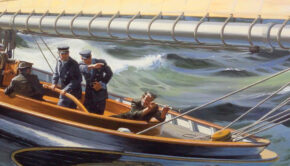
The Last Days of the Schooner America →

America’s Cup: Half the crew will pedal →
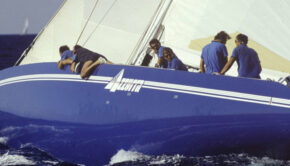
Italy and the America’s Cup →
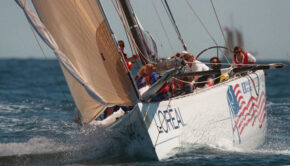
Opening door for women →
© 2024 Scuttlebutt Sailing News. Inbox Communications, Inc. All Rights Reserved. made by VSSL Agency .
- Privacy Statement
- Advertise With Us
Get Your Sailing News Fix!
Your download by email.
- Your Name...
- Your Email... *
- Email This field is for validation purposes and should be left unchanged.


- CLASSIFIEDS
- NEWSLETTERS
- SUBMIT NEWS
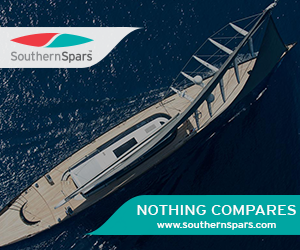
J Class Yachts were born from the introduction of the 'Universal Rule' in 1930, which for the first time efficiently controlled the size and performance of yachts built to compete for the America's Cup. Ten massive yachts conforming to the J rule were built between 1930 and 1937, although more were designed and tank tested. They were all but extinct, however three English yachts survived.
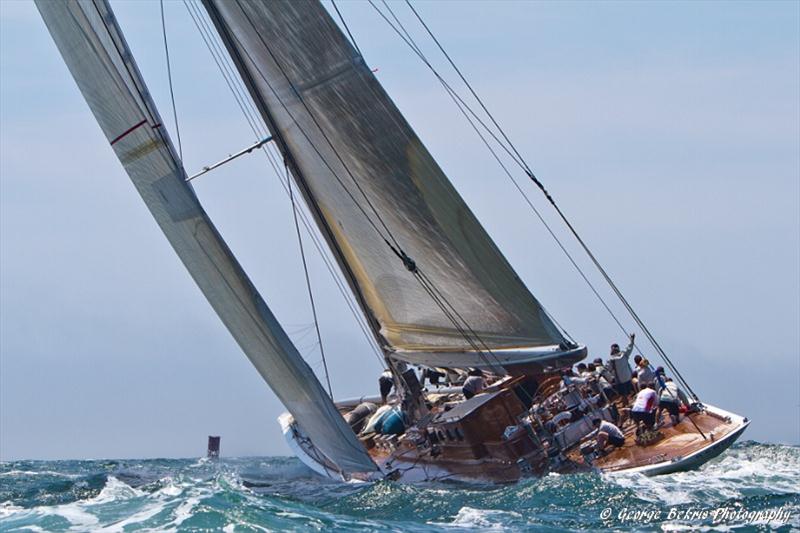
- Latest videos, from 2023
- Oldest videos, from 1931 onwards
Show photos from latest 2024 2023 2022 2021 2020 2019 2018 2017 2016 2015 2014 2013 2012 2011 2010 2009 2008 2007 2006 2005 2004 2003 2002 2001 2000 1999 1998 1997 1996 1995

Story of the J-Class Yachts:
The J-Class was adopted for America's Cup competition in 1928, looking forward to the next regatta in 1930. The Class itself, though, dated back to the turn of the century when the Universal Rule was adopted though no J-Class yachts had yet been built.
The Rule used a yacht's various dimensions to calculate an equivalent rating in feet. Boats of equal rated lengths could then race against each other directly without making other allowances for time or distance sailed. Even though one yacht might have a longer length or another yacht a larger sail area, their overall configurations had to produce a rated length that met the Universal Rule for that class. Boats in Class J, more commonly today termed J-Class yachts, were the largest constructed under the Universal Rule. The Rule actually includes provisions for an even larger type of boat, the I Class, though none were ever built. Inquiries made in the 1930s for a Defense in the smaller K Class were rejected.
The J-Class were the first yachts in an America's Cup match to be governed by a formal design rule. Previous defenders and challengers were only restricted by minimum and maximum lengths set forth in the Deed of Gift. Sir Thomas Lipton, challenging in 1930 for the fifth time, had held earlier discussions with the New York Yacht Club in hopes of adopting the Universal Rule for the previous America's Cup match, intended for 1914 but delayed until 1920. Though an agreement to use the rule was not reached for that match, the 1914 US boats, Vanitie and Resolute, still roughly followed J-Class parameters.
Building Program:
There were only 10 J-class yachts designed and built. Additionally, several yachts of closely related dimensions, mostly 23-Meter International Rule boats, were converted after their construction to meet the rating rules of the J-Class.
Only the purpose-built Cup yachts, though, could compete in the America's Cup. The "converted" J-Class yachts, while acceptable for Class racing events, were not admissible for America's Cup competition. Responding to issues that surfaced in earlier defenses, the America's Cup rules required that all boats had to be sailed to the event on their own bottom. Some critics pointed out the possibility that the challenger might, as a result, be disadvantaged by being of heavier construction than the defender. In order to avoid a situation that could be perceived as an undue advantage, the NYYC eventually agreed that all America's Cup J-Class yachts would be built to Lloyds A1 standards, ensuring that defender and challenger met the same minimum construction specifications (the nautical term is "scantlings"). Most existing yachts were not built to such standards, so the Cup-eligible boats thus ended up heavier than the ineligible J's.
(The issue of challengers having to build heavier boats due to the ocean crossing was a popular, if uncertain, explanation in the British press for the long string of American victories. In practice, a number of challengers added internal bracing for the crossing, which was then removed before racing. And on a few occasions defenders subsequently made the crossing in reverse in search of competition following their successful defense. The rule requiring that the challenger sail to the event on her own bottom was actually instituted in response to a super-lightweight challenger towed to the match through canals and rivers from Canada.
The J-Class Yachts
Disposition:
Conceived at the height of the affluent 1920's, the J-boats arrived during the Great Depression. They required enormous crews, and, despite expert attention to their technical details, still broke an astonishing number of masts. While they were in most regards the most advanced sailing yachts yet built, and they were indeed powerful sailing thoroughbreds formed in sleek lines that can race the pulse of almost every viewer, the glorious J's proved too extravagant for their own good. Most had very limited sailing careers outside of America's Cup. Ranger , whose 1937 cost was upwards of $500,000, was laid-up at the end of her debut season and never sailed again. All of the American J's were scrapped between 1935 and 1941. Most of the British J's were either abandoned or scrapped.
When NYYC sought to revive the America's Cup in the 1950s, there was a faction that favored returning to the J-Class. Mike Vanderbilt even stated that not only would he like to see the Cup contested in the large boats, but that if so he would consider rebuilding a new Range r to the design of the original. Still, another faction hoped for smaller dual-use yachts that could be used in offshore racing when the Cup year was ended. With cost estimates for a 1958-era J starting around three million dollars, the impulse for a J-Class defense faded away in the face of economic pressures and a compromise was reached to sail the America's Cup in International Rule 12-Meters.
The J-Class Resurgent
J-Class rigs today are no longer built of wood or dur-alumin, but with modern lightweight composites. Their sail technology is long past being canvas duck, and many other subtle changes have been made to make the ongoing maintenance and operation of these yachts a realistic proposition. Still, the J-Class owners have gone to great lengths to insure the integrity of the boats. The J-Class is self-administered, rather than governed by an outside organization as is the case with almost all other classes. This allows the members to more easily adapt the rules in order to serve the needs of these uniquely historic yachts.
Most of the surviving J's are available for charter. Cambria was reportedly for sale in 2000. Endeavour changed hands in 2006 for a reported $13.1 million USD, though as her former owner Dennis Kozlowski said, "No one truly owns Endeavour . She's a part of yachting history.''
Recreations, Replicas, and a Tender:
For decades, most yachting fans thought that we would never again see the likes of these boats again, the few survivors would sooner or later fade away, and the whole history would be reserved for books and fading photographs, but following the restoration of the surviving hulls rumors grew throughout the late 1990's and early 2000's about building "new" J's. In 2001, all of this dock talk began to become reality:
Ranger Wooden Boat magazine, March/April 2001, described a "Dutchman" who had commissioned a new Ranger built to the original's plan. This incredible rumor came true, and a piece of lost sailing history was brought back to life. The new version of this "Superboat", as Mike Vanderbilt once called her, was officially launched in October, 2003.
Designed by Studio Scanu and Reichel-Pugh, and built by Danish Yachts, Skagen, Denmark, she is not an exact replica of the original. Some would term her a re-interpretation, as a number of changes were made including greater freeboard, and Ranger 's original designers did not participate in the project. The new Ranger first competed head-to-head against other J's in Antigua, Spring, 2004. It took some additional adjustment after launch by her owners and designers to seek the proper trim that would make her float on her lines, an essential step in the process of being officially rated a J-Class yacht. Visit the Ranger Website for more info. J-Class Management is also at work on a restoration of Bystander, tender to the original Ranger .
Endeavour II An Endeavour II replica is being built at Royal Huisman Shipyard, with a planned 2008 launch date. Gerard Dykstra and Partners is leading the project, which features a lightweight Alustar (aluminum alloy) hull and carbon-fiber mast. See additional photo at Yachtspotter
Lionheart Based on an unbuilt alternate design by Starling Burgess and Olin Stephens II that was considered for 1937's America's Cup defender Ranger , this new boat is being built at yards in the Netherlands for an expected 2008 launch. Lionheart will be the longest J-Class yacht when completed. See more including photos of the completed hull at the Lionheart Website and the story of sailing onboard including photos and videos Cruising J-Class Style Aboard Lionheart at Yachting World Designer: Hoek Design Builders: Bloemsma Aluminiumbouw and Claasen Jachtbouw BV
Svea Tore Holm's unbuilt 1937 design, said by some to be faster in the test tank than any of the original boats, is being pursued by Hoek Design
Name To Be Announced In late March 2008, reports of another replica about to begin construction appeared on the Classic Boat website . Whether this is one of the known projects, such as Svea , above, or yet another replica about to become reality, such as Rainbow , below, should become known shortly.
Rainbow In late May, 2008, Dykstra and Partners announced that a new build of the 1934 America's Cup Defender Rainbow was underway, with an expected launch date of 2010. Read the Press Release
Other projects: Hoek Design is also studying replicas of 1930's Enterprise and another boat from Yankee designer Frank Paine. Yankee herself has also been rumored as a new project, as well. Earlier reports of a Ranger alternate-design carrying the name of Seawolf may have been referring to the project that has become Lionheart , see above. Whirlwind and Weetamoe are the only two designs of the original ten J's that aren't known to be sailing, building, or under serious consideration as of 2008. The J-Class website points out that there are 10 unbuilt J designs from the 1930's, so the possibilities for more J-Class yachts are intriguing.
Yachting World reported in May, 2003 , that construction was underway on a yacht replicating the famous G.L Watson design Britannia . Photos showed a nearly completed hull at Solombala Shipyard, in Arkhangel, Russia, and included interviews with the yacht's owner Sigurd Coates of Norway. The design was adapted by Cesil Stephansen from published plans. The original designer's modern descendent company, G.L.Watson & Co., Ltd., has no involvement with the Arkhangel boat. Little was been heard of this ambitious project for years, until the yacht was finally launched only to become subject of a financial dispute, trapping her in Russia until 2009, when she "escaped" to Norway.
In the Spirit
A similar project to return elegant yachts to competitive racing, the W-class, was set in motion by Donald Tofias, an American enthusiast. He commissioned naval architect Joel White to design a new class with lines evocative of famous racing yachts like the New York 50's and the J-Class. The first two boats, Wild Horses and White Wings , were built in Maine of modern cold-molded wood construction and launched in 1998. It is Tofias' aim that there will eventually be a whole fleet of the beautiful W-class to regularly compete against each other. The one-design W-76 is actually similar to the New York 50's. Tofias' long-range plans involve a range of classes including 46, 62, 76, 105, and 130. The 130's would be nearly identical in basic dimensions to the J-class. See the W-Class Websit e .
Additional Links: Chris Cameron onboard Ranger at Maxi Yacht Rolex Cup, 2010: Photo Gallery
Web Sites of Particular Interest: The J-Class Association J-Class Management, Inc.
Further Notes:
K-Class: The Royal London Yacht Club made and withdrew its inquiry for a K-Class challenge in 1935. The intent had been to reduce costs, not the least of which was hoped to be a lower velocity of mast replacement, but the K-Class line of thought was rejected for several reasons. For one, the K-Class wasn't so much smaller than the J-Class as to have clearly led to significant savings. Additionally, no K-Class yachts existed on either side of the Atlantic while several J's of various pedigree were available for testing, training, and racing in 1935. Also a factor was that the NYYC was already actively considering another challenge at the time the RLYC began their communication about the K-Class and it was the NYYC's policy to consider only one challenge at a time, in keeping with the Deed of Gift.
Sailing to the Event on Own Bottom: This provision of the Deed of Gift was at times strictly interpreted to the the degree of making sure that the challenging yacht actually was under her own sail while traveling to the match, not towed by another boat. Challengers returning across the Atlantic after Cup matches concluded were sometimes towed for convenience. Eventually the NYYC agreed at various times to permit towing the yachts to the match, particularly when conditions were light, and in 1956, for the coming of the 12-meter yachts in 1958, the Deed of Gift was amended to eliminate the requirement.
CupInfo Home

The global authority in superyachting
- NEWSLETTERS
- Yachts Home
- The Superyacht Directory
- Yacht Reports
- Brokerage News
- The largest yachts in the world
- The Register
- Yacht Advice
- Yacht Design
- 12m to 24m yachts
- Monaco Yacht Show
- Builder Directory
- Designer Directory
- Interior Design Directory
- Naval Architect Directory
- Yachts for sale home
- Motor yachts
- Sailing yachts
- Explorer yachts
- Classic yachts
- Sale Broker Directory
- Charter Home
- Yachts for Charter
- Charter Destinations
- Charter Broker Directory
- Destinations Home
- Mediterranean
- South Pacific
- Rest of the World
- Boat Life Home
- Owners' Experiences
- Interiors Suppliers
- Owners' Club
- Captains' Club
- BOAT Showcase
- Boat Presents
- Events Home
- World Superyacht Awards
- Superyacht Design Festival
- Design and Innovation Awards
- Young Designer of the Year Award
- Artistry and Craft Awards
- Explorer Yachts Summit
- Ocean Talks
- The Ocean Awards
- BOAT Connect
- Between the bays
- Golf Invitational
- Boat Pro Home
- Pricing Plan
- Superyacht Insight
- Product Features
- Premium Content
- Testimonials
- Global Order Book
- Tenders & Equipment
J Class Yachts
Go inside the world of the iconic J Class yachts with reports on board these famous vessels, interviews with their owners and coverage of the J Class World Championships. Boat International is the official media partner of the J Class Association.
LATEST J CLASS NEWS AND FEATURES
Boat presents, from our partners, sponsored listings, yachts for sale, sailing news, more j class news and features.
J Class Yachts For Sale (Sail)
- Upcoming Events
- AMYA J CLASS History
- Stuff for Sale
- Construction Videos
Understanding the AMYA J Class Model
By john hanks iii.
Understanding An AMYA J Class Model
Let me begin by saying that the AMYA J Class models are BIG. The J Class models are 1/16th scale models of the full-size J Class yachts that Raced for the America’s Cup in the 1930s.
The full-size yachts were between 120 and 135 feet long and after doing the math, that gives you a model 90 to 101 inches long. To put that in perspective, that is as long as two Marbleheads end to end. In fact some of the J models have main booms as long as a Marblehead.
The weight of the Js, when they are ready to sail, matches their dimensions, with the lightest being about 65 pounds and the heaviest about 95 pounds.
The masts are also huge, ranging from 8 feet above the deck to over 9-1/2 feet above the deck.
The size of the models and the fact that they have scale hulls presents some unique problems for the J owner. Probably the most obvious question is “How do I get my model to and from the lake?” Well it takes a little planning and a large vehicle of some kind. I know of J owners who have purchased trailers for their Js, while others transport their model Js in full-size pickups or vans. I have also witnessed a J model arrive at a regatta, from Oklahoma, in a mid-size hatch back, with the stern resting on the dash and the bow just under the hatch glass on in the back. I can imagine how that affected the conversation between the driver and passenger. I carry my J models in a 1956 Chevy station wagon. It was a great excuse to buy a classic car.
The next question is “How do I get my 90 + or – pound model in the water once it is ready to sail?” Well it takes two people that are willing to lift your model and carry it to the water and then not mind getting their feet wet as they set it in the pond. Hopefully you have brought that willing individual with you to the pond so you do not have to persuade a by-stander to be your assistant. I am very fortunate in that my wife, Barbara, is always a willing deck hand when it comes to working with the models.
The scale aspect of the model produces some handling characteristics that are somewhat different than those associated with a modern fin-keel model. When the boats are scaled down, and this is true of any scale model sailboat, the wind and water do not scale down in the same proportions. You lose stability in the hull faster than you lose the power of the wind in the sails. Several things come together in a model J to help over come this phenomenon. First, the percentage of ballast weight to total displacement is much different in a model J than a full-size yacht. The full-size yacht is doing well to get 40% of the total displacement in the ballast, while a model J can get 70% or more in the ballast.
Second, the J Class allows a 2 inch extension to the keel depth to increase stability. This adds to stability in two ways; first it lowers the center of gravity slightly; and second, it adds volume to the hull, which needs added ballast for the model to get to the proper water line. The 2-inch keel extension forces the addition of between 5 and 10 pounds of ballast to the total displacement over and above the scale displacement. Most of the model Js also sail with a reduction in sail area compared to a truly scale sail plan. Most of the model Js would carry about 4,200 square inches of sail in a full-size, scale sail plan. The best all round sailing model Js carry a sail plan with about 3,500 square inches on the larger models, such as Ranger or Endeavour, and 2,900 square inches on the smaller models such as Shamrock V or Enterprise. This change allows them to sail in a fairly broad range of wind conditions.
How do the boats handle on the water?
In short, they sail and handle like a big boat. They do not turn on a dime like the smaller fin-keel boats most of us are used to sailing, so it takes a little planning to get around the race course, especially if you are in a fleet. The models are deceptively fast because their great size fools you into thinking that they are moving more slowly than they actually are.
All of this takes a little getting used to for the first time J skipper, but all of the skippers who have sailed a model J get to love it very quickly. Most of the skippers cannot get over how stable and solid the boats feel. They are not twitchy in the puffs, within reason of course, and they handle with light control inputs.
The majesty and grace of a J Class yacht on the water carries over from the full size yachts into the models. It is hared to describe the beauty of a fleet of J Class models as they make their way around the marks.
AMYA J CLASS
1330 North Andrew Drive, Kuna, Idaho 83634, United States
Copyright © 2022 AMYA J CLASS - All Rights Reserved.
Yachting World
- Digital Edition

J Class picture highlights: spectacular images of 7 J Class sailing together at the 35th America’s Cup
- Toby Hodges
- June 21, 2017
The largest collection of J Class yachts yet – seven of the now nine strong J Class fleet – raced during the America’s Cup in Bermuda in June.

It is a sight many sailors have looked forward to as much or even more so than the America’s Cup itself – Seven J Class , the largest fleet to ever assemble in the 87 history of the class, raced in their own regatta either side of the first weekend of the America’s Cup finals.
The J Class also performed a stunning exhibition race on the America’s Cup course on the Great Sound on Saturday, shortly before the first America’s Cup match, for the thousands of fans in the America’s Cup village. (The shallow, reef-strewn depths of the Great Sound make it very tricky to set a proper course for the J Class, hence the actual races were held off the north coast of the island).
A combination of having some of the world’s best photographers here and the J Class racing on translucent turquoise blue seas means the resultant photographs (below) make for a visual treat.
Lionheart scored a first and second on the final day to win the J Class regatta, which concluded in a light breeze off the north coast of the island. It was reduced to a two day, five race event after Friday’s racing was canceled due to light wind.
The fleet was also without its newest member Svea for the final three races, after she suffered rig damage durig the second race (pictured below). But the crews at the prize giving were all delighted with how close the racing was in the light, flat water conditions – a fleet divided and decided literally by seconds.
Here is the best of the Js in Bermuda in pictures

Seven J Class hit the startline for the first time ever. The smaller Shamrock chose port hand starts to keep clear air – Studio Borlenghi

JK7 Velsheda and JS1 Svea add some colour to the otherwise black and white sail wardrobe – Studio Borlenghi

The long aft overhangs of JK6 Hanuman during Monday’s triple race day – Chris Cameron

The precarious pointed bow of a J Class highlights the skill of the bowman. Topaz on the greener, clearer waters of the Great Sound – Ricardo Pinto

The Js dance elegantly around the Great Sound off the America’s Cup village during the J Class exhibition – Ricardo Pinto

The exhibition saw staggered starts in a light breeze but a perferct opportunity to see the skills involved with getting the vast sails up and down around a simulated race course – Ricardo Pinto

Hanuman leads Ranger and Svea during the first day of the windward/leeward J Class Regatta. The final results came down to seconds. Chris Cameron

The view from the weather rail of Shamrock as the six other Js round the mark ahead, Velsheda leading. The smaller Shamrock can only try and compete with the others on handicap.

Preparing to hoist on the foredeck of Hanuman. She has been highly optimised and is the only J to use a snuffer to allow faster kite drops on mark roundings. Ricardo Pinto

The view from the America’s Cup village as the J Class perform their exhibition race. Sander van der Borch

Kristy Hinze Clark, Hanuman’s owner, enjoys helming the boat during the exhibition match – Studio Borlenghi

Onboard the newest J Svea, with her clean deck layout and extra large wheel, with Ranger and Hanuman chasing – Studio Borlenghi

Velsheda’s foredeck crew, led by Jeff Reynolds and Eduard van Lierde prepare to hoist the red white and blue spinnaker – Ingrid Abery

Weight forward on Lionheart on their way to winning both the Superyacht Regatta and J Class regatta in the light airs of Bermuda – Ingrid Abery

The seasoned competitors Ranger (left), Velsheda and Lionheart find their lane at the leeward end of the line – Studio Borlenghi

A seven strong fleet means it’s a gutsy affair at the pre-start and a good reason why the top pros are needed aboard to make the split-second calls – Studio Borlenghi

Bermuda’s picture postcard conditions. The combination of enticingly clear, flat water, ideal temperatures, light breezes and welcoming locals makes for a spectacular venue – Ricardo Pinto

The newest J Class, a Hoek rework of a Tore Holm design, looked superb in her first regatta and was going well until she suffered rig failure (below) in her second race. Studio Borlenghi
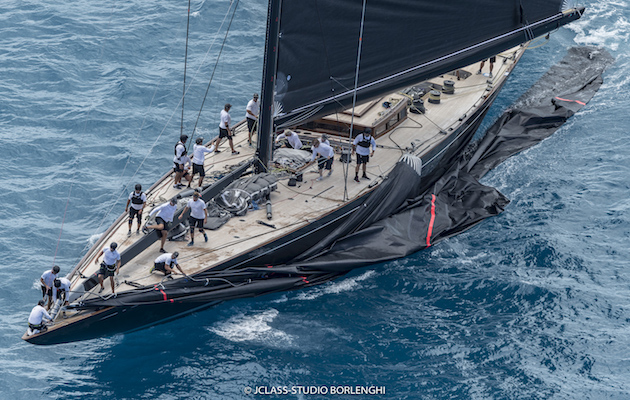
There was a loud bang as Svea approached the top mark – the headstay swivel broke and the stay and genoa collapsed. The crew reacted quickly to release the mainsheet and runners and crank on halyards to the foredeck to keep the mast standing. It is hoped Svea will be fixed in time for the J Class Worlds in Newport in August. Studio Borlenghi
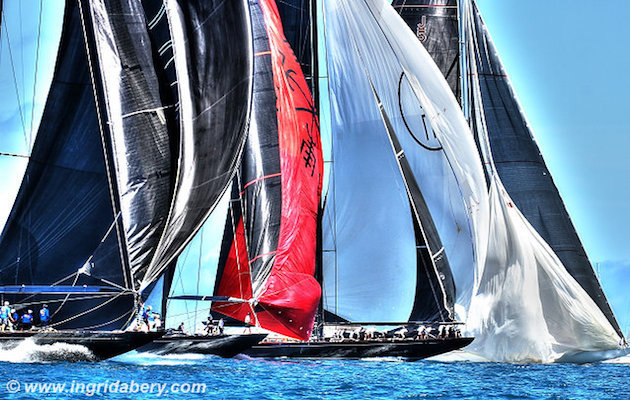
The race to the downwind gate and who can get the vast genoas up and kites down quickest – Ingrid Abery

The red socks of Ranger in support of Emirates Team New Zealand (famously worn by Sir Peter Blake) – Gilles Martin-Raget

Following a poor start and a tense finish to the last race, Lionheart wins the America’s Cup J Class Regatta. It marked triple success for the JH1 team in Bermuda, after also winning their class and the overall prize in the Superyacht Regatta. Some of her Falmouth based crew hoist the Cornish flag in celebration – Ingrid Abery
Latest News
J class duo velsheda and hanuman heading to saint barths bucket.

The renowned Saint Barths Bucket superyacht regatta has long been popular with J Class yacht owners and crews, many of whom have enjoyed success at the Caribbean spring showcase event over recent years.
Svea find more joy in Ibiza

The well drilled Svea team continued their winning ways when the Swedish flagged recent winners of the Maxi Yacht Rolex Cup raced against Topaz under the J Class Association rule last week at the third edition of Ibiza JoySail.
J Class take centre stage on opening day of Ibiza JoySail
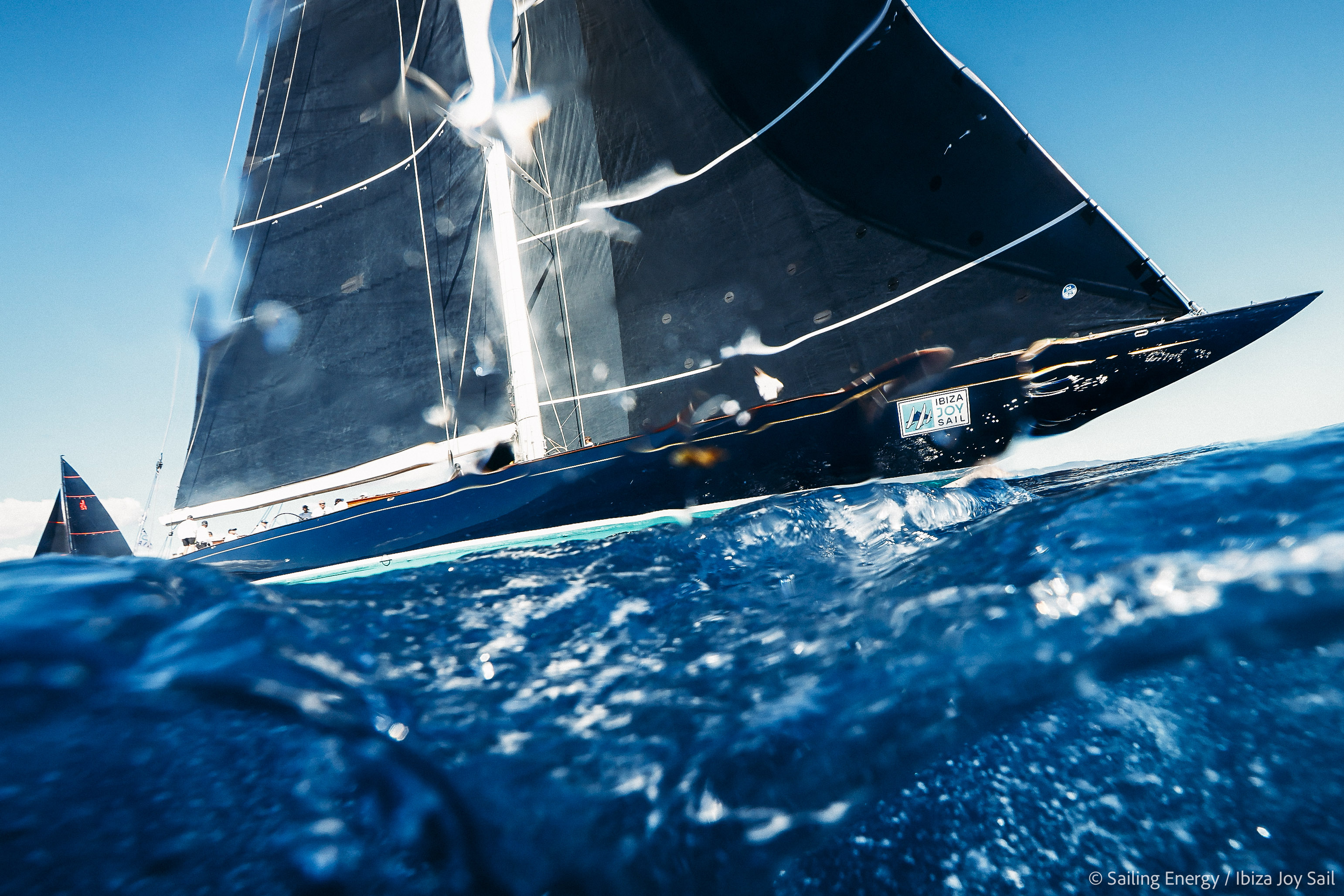
The J Class took centre stage on the opening day of Ibiza JoySail 2023. Svea and Topaz were the first to stretch their legs in the superyacht race that closes the Mediterranean season.
J Class pair line up in Ibiza
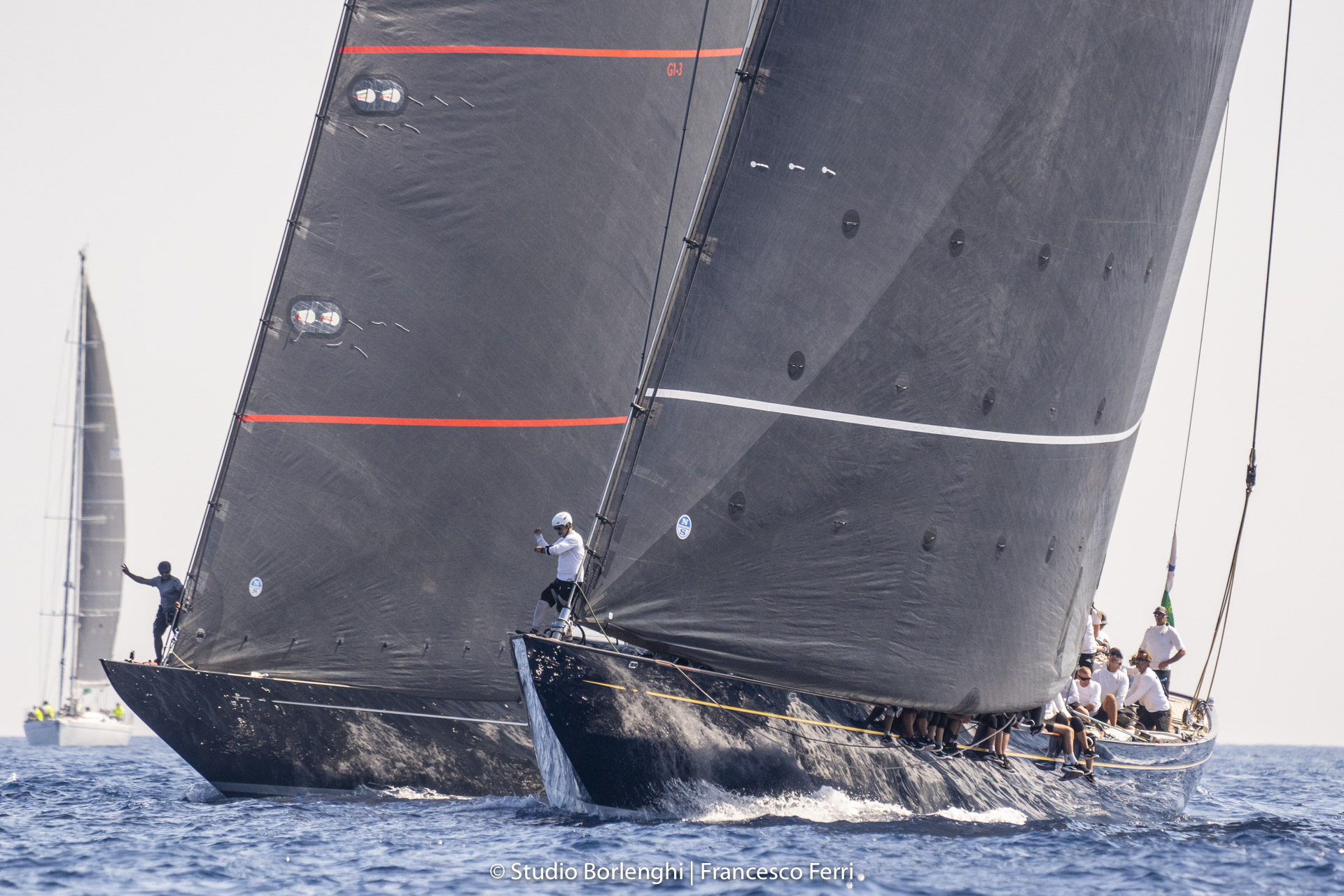
J Class pair Topaz and Svea will line up over the next four days on the beautiful waters off Ibiza and Formentera as they compete at the third edition of the Ibiza JoySail regatta

Super Swedes Svea are Maxi Yacht Rolex Cup J Class Champions for a second time

Svea’s unbeaten run of six wins from six starts remains intact and the Swedish flagged team retain the J Class title which they won last year. They led four races through the finish line whilst Velsheda took two winning guns but lost out on corrected time.
Swedish Svea assured of Maxi Yacht Rolex Cup J Class title for second year in a row

Svea today further enhanced an already unbeatable position at the top of the J Class leaderboard with a sixth consecutive race win at the Maxi Yacht Rolex Cup.
Svea’s winning streak extended

Two further race wins for the Swedish flagged Svea means the team are well set to collect the top award for the three-boat class at Saturday’s prizegiving at the Yacht Club Costa Smeralda.
Svea win first coastal race with Costa Smeralda at its best

For the second day of the Maxi Yacht Rolex Cup, Porto Cervo and the Costa Smeralda delivered picture postcard exciting, racing conditions.
Svea’s perfect start as J Class trio line up at Maxi Yacht Rolex Cup

Swedish flagged Svea made the best possible start to their defence of the J Class Maxi Yacht Rolex Cup title, when they opened with two wins.
J Class to hold 2024 World Championships in Barcelona in 2024

With the America’s Cup in Barcelona in October 2024, the J Class have been welcomed by America’s Cup Events to host their World Championships between 7-11th October 2024 with a practice regatta on the 3-4th October 2024.
Enthusiasm at a high as J Class trio prepare for next week’s Maxi Yacht Rolex Cup
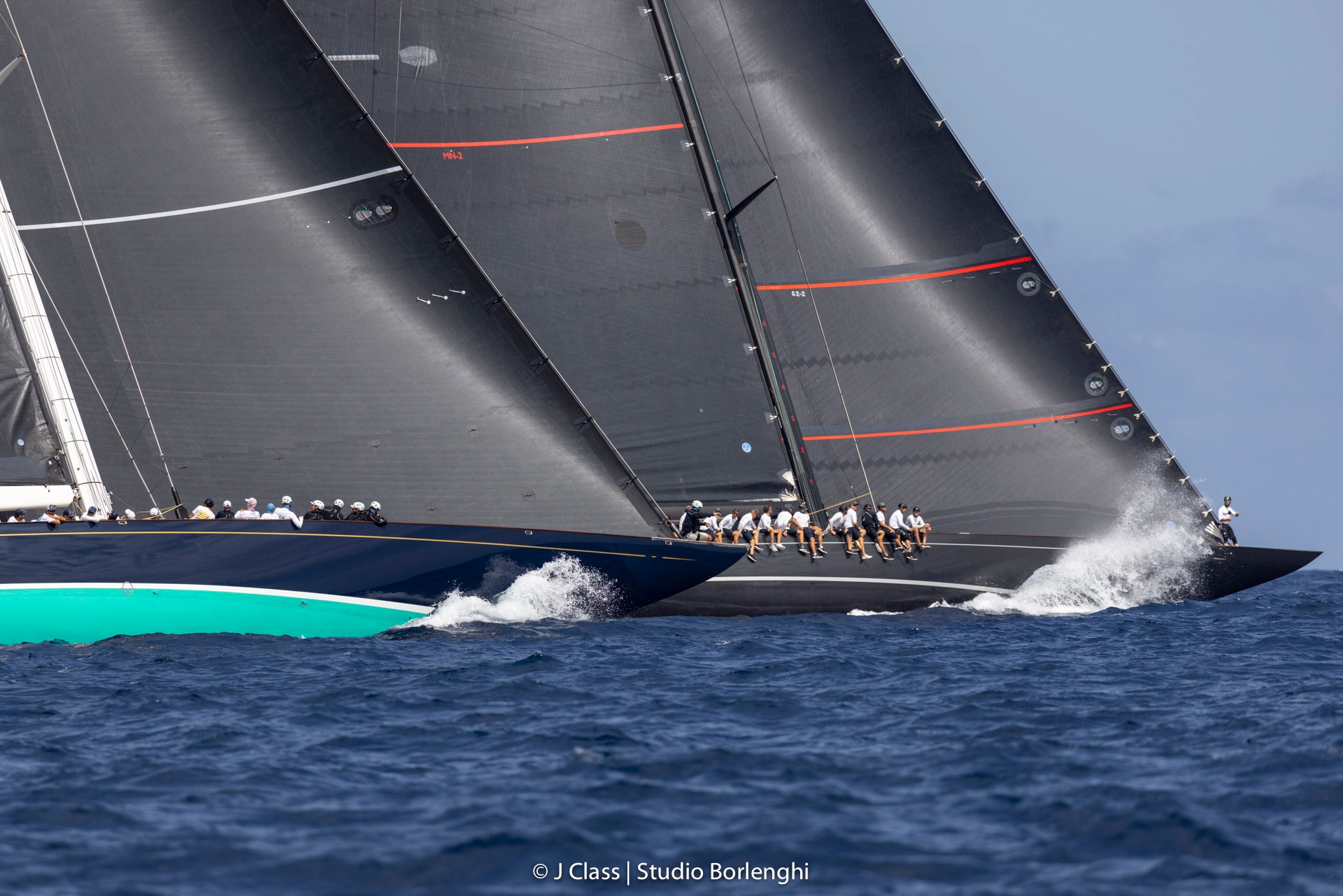
A heightened mood of excitement and anticipation will be evident among the J Class fleet as crews assemble and complete final training and preparations this weekend ahead of the Maxi Yacht Rolex Cup which starts on Monday 4 September on Sardinia’s beautiful Yacht Club Costa Smeralda
Velsheda win class at The Superyacht Cup Palma, Svea take second

After three days of racing on the Bay of Palma at the 2023 Superyacht Cup, J Class duo Velsheda and Svea took the top two places in the four boat Class A racing under ORC Superyacht handicap.
Velsheda wins opening race at The Superyacht Cup Palma

Superyacht Cup Palma 2023 got underway today in typically excellent sailing conditions out on the Bay of Palma, with an 8 to 10 knot breeze under blue skies greeting the diverse fleet gathered for the 27th edition of Europe's longest running superyacht regatta.
Velsheda and Svea set to race at The Superyacht Cup Palma
.jpg)
Two J Class yachts will race at the popular Superyacht Cup Palma over the coming days. Both Velsheda, which has just been relaunched after a long refit, and Svea will compete, racing in a mixed nine boat fleet under the ORC Superyacht rule.
Doyle Sails confirmed as an official Partner of the J Class Association

Doyle Sails is excited to announce that it has been confirmed as an official Partner of the J Class Association, offering expert support and experience to the prestigious fleet ahead of the 2023 sailing season.
The 2022 season represents a strong foundation for the J Class future
.jpg)
The 2022 season has seen the J Class gather considerable momentum. After five years marked by limited and sporadic racing at mixed fleet regattas, this season followed a consolidated, popular programme of class racing at three great events in the Caribbean and Europe.
Andy Beadsworth reviews Velsheda's Maxi Yacht Rolex Cup

Velsheda's Andy Beadsworth reflects on the Maxi Yacht Rolex Cup
Topaz's Peter Holmberg on the Maxi Yacht Rolex Cup & more

As the Maxi Yacht Rolex Cup draws to a close, Peter Holmberg (Topaz) reflects on the event and what's to come for the J Class
Ice Cool Swedes Svea Win J Class Maxi Yacht Rolex Cup Title, Ranger are 2022 Season Victors

A Mistral wind with gusts to over 30 knots thwarted efforts to run racing on the final day of the 2022 Rolex Maxi Yacht Cup on Sardinia's Porto Cervo
Svea on song for breezy win at Maxi Yacht Rolex Cup

A fresh north-westerly Mistral breeze of 20-23 knots accompanied by beautiful sunshine provided classic Porto Cervo conditions for the J Class today, which saw the Swedish flagged Svea score their fourth race win at the Maxi Yacht Rolex Cup.

This site uses cookies to enhance your experience. By continuing to browse the site, you consent to the use of cookies. View our Privacy Policy for more information.

IMAGES
VIDEO
COMMENTS
A table of well-known J Class yachts demonstrating that application of the Universal Rule could result in a rating from 65 to 76 feet (20 to 23 m). Length overall (LOA) of the yachts ranged from 119 to 139 feet (36 to 42 m). Sail areas of the yachts ranged from 7,288 to 7,651 square feet (677.1 to 710.8 m 2 ).
LOA: 39.31m/128ft 12in · LWL: 27.30m/89ft 7in · Beam: 6.68m/21ft 11in · Disp: 175 tonnes Original lines: Charles E Nicholson Modified design: Dykstra Naval Architects Launch year and yard: 1934,...
October 9, 2023 Only ten J Class yachts were built before the Second World War stopped the movement in its tracks, but in the last 20 years these magnificent sloops have made an incredible...
Shamrock V Sail number: JK3 Length: 36.5m Year of build: 1929 With more than 80 years under her keel, Shamrock V is one of the most historic sailing yachts still afloat today having been built by Camper & Nicholsons in 1929. Her current owner bought Shamrock V in March 2016 and in the process inherited a legacy.
That's a collective weight of around 1,600 tonnes, with a sail area over 8,360m2 (90,000ft2). Stack the J Class masts up end to end and they would reach the top of the Empire State Building....
But such is their capacity to entrance, these 36-metre to 43-metre sloops, with their giddy overhangs fore and aft, have actually grown in number since 2001. Today the fleet numbers nine yachts, with a further two on the drawing board.
Ten yachts were built to the J Class specifications between 1930 and 1937, six in. America and four in Britain. In addition, six other large yachts sailing at the time had ... This allowed the crew to control the. shape of the sail at the foot, improving the drive in the bottom third of the sail. ... as the full size yachts are in real life ...
The Swedish naval architect and boatbuilder Tore Holm, famous for his Six Metre and Eight Metre class racing yachts, had turned his pencil to the far bigger Js and he set out to design to the longest LOA the class would allow.
Published on June 26th, 2017. J Class yachts, which reigned supreme in the 1930s, are making a thrilling comeback, with restorations, new builds and the biggest fleet the class had ever seen at ...
J Class. J Class Yachts were born from the introduction of the 'Universal Rule' in 1930, which for the first time efficiently controlled the size and performance of yachts built to compete for the America's Cup. Ten massive yachts conforming to the J rule were built between 1930 and 1937, although more were designed and tank tested.
Disposition: Conceived at the height of the affluent 1920's, the J-boats arrived during the Great Depression. They required enormous crews, and, despite expert attention to their technical details, still broke an astonishing number of masts.
August 11, 2017 shares A record fleet of seven J Class yachts in Bermuda represented the purer form of the sport for many America's Cup fans. Toby Hodges reports. TAGS: Everything you need to...
The J Class. J Class yachts were originally built to the specifications of the Universal Rule. The J Class really represents the golden age of racing for the America's Cup in the 1930s when this Universal Rule was used as the determining measurement system. J Class yachts were originally built to the specifications of the Universal Rule.
In 1929 Sir Thomas Lipton, who had reached worldwide fame through his tea business issued his fifth challenge for the America's Cup and commissioned Charles E. Nicholson, to design the first J-Class Yacht, Shamrock V, to the Universal Rule, signifying the birth of the J Class and the start of a new era in design evolution and racing.
In total nine J Class yachts are currently active, including three original surviving Js - Velsheda, Shamrock and Endeavour - and six replicas that have been built since 2003; Ranger, Rainbow, Hanuman, Lionheart, Topaz and Svea. Endeavour, JK4 Topaz, J8 Svea, JS1 Velsheda, JK7 Rainbow, JKZ1 Shamrock V, JK3 Hanuman JK6 Ranger, J5 Lionheart, JH1
The Js' original measurement was to the Universal Rule, which created hulls between 76-87ft LWL, 120ft-140ft LOA, and displacements between 130-170 tonnes. The AC48 class is nearly two thirds...
The owner then informed Hoek he'd like to build a new yacht based on that design. Warm, teak paneling lines the bulkheads, and nothing is fussy or overstuffed. Measuring 43.4 meters (142 feet), Lionheart is the longest J Class in existence. She also has astounding 17-meter (56-foot) overhangs. She's built entirely of aluminum, something the ...
J Class Yachts. Go inside the world of the iconic J Class yachts with reports on board these famous vessels, interviews with their owners and coverage of the J Class World Championships. Boat International is the official media partner of the J Class Association. Editorial Features. Svea: Inside the newest member of the J Class fleet.
The J Class models are 1/16th scale models of the full-size J Class yachts that Raced for the America's Cup in the 1930s. The full-size yachts were between 120 and 135 feet long and after doing the math, that gives you a model 90 to 101 inches long. To put that in perspective, that is as long as two Marbleheads end to end. In fact some of the ...
Videos | | J Class Superyacht Cup Palma: Fleet of Js set to race The purist's America's Cup - the story of the seven-strong J Class Regatta in Bermuda J Class picture highlights: spectacular...
The J Class Association was founded in 2000 to protect the interests of the Class, present and future, and organises an annual calendar of racing for these magnificent yachts. 2024 Calendar. 19-22 June.
June 21, 2017 0 shares The largest collection of J Class yachts yet - seven of the now nine strong J Class fleet - raced during the America's Cup in Bermuda in June. TAGS: Everything you...
News. A fresh north-westerly Mistral breeze of 20-23 knots accompanied by beautiful sunshine provided classic Porto Cervo conditions for the J Class today, which saw the Swedish flagged Svea score their fourth race win at the Maxi Yacht Rolex Cup. All of the latest news and updates from the J Class Association.